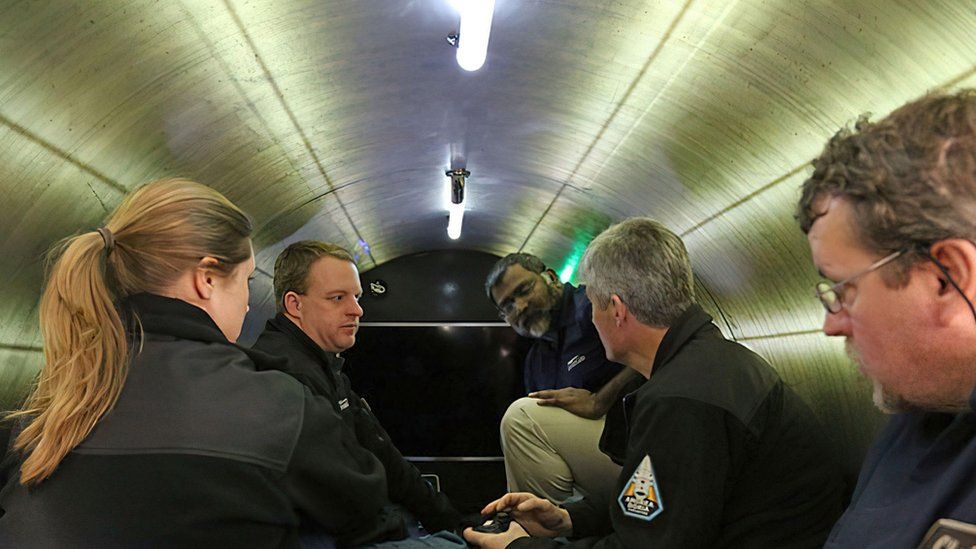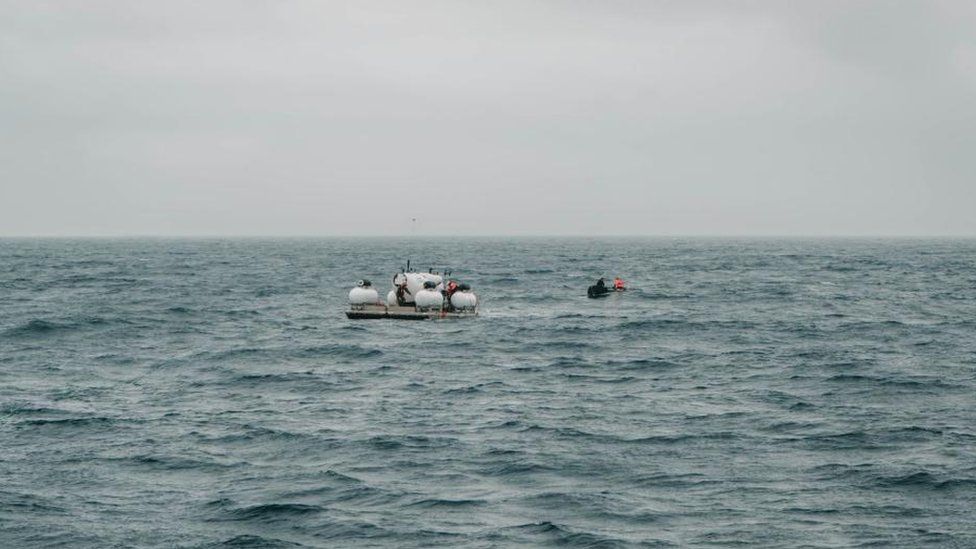Titan sub has heated walls, private toilet and video game controller
Before the five-person crew of a missing submersible vessel began to descend to the ocean floor, they first had to be locked inside by a support crew who sealed it shut with bolts.
A search is now underway to locate the small, deep-diving vessel – which is operated by the marine company OceanGate Expeditions – after it lost contact while diving near the wreckage of the Titanic.
What is the Titan?
It is one of the world’s only privately owned manned submersibles.
While OceanGate has also operated a sister submersible called the Cyclops since 2015, the Titan was expressly built by the company to allow tourists to visit the wreck of the Titanic.
According to the company, the Titan weighs some 23,000 lbs (10,432 kg) and has an aerospace-standard five-inch thick carbon fibre hull reinforced with two domed titanium end caps.
It is capable of reaching depths of up to 4,000m (13,123ft) below sea level, far more than the deepest diving US submarine – the USS Dolphin – which once reached 900m below sea level.
For context, the wreck of the Titanic sits 3,800m below the surface.

Unlike a submarine, submersibles have limited power reserves and need a separate support vessel that can launch and recover them, according to the US National Oceanic and Atmospheric Administration.
The Titan began sea trials in 2018, before undertaking its inaugural journey in 2021. Last year, it made 10 dives although not all of these were to the Titanic wreck.
Once detached from its launch and recovery platform, the sub’s four electric thrusters help it reach speeds of around 3 knots (3mph; 4km/h).
In one journey the company can go through $1m worth of fuel, OceanGate CEO Stockton Rush told CBS News last year.
What’s it like inside?
The sub itself is extremely narrow, measuring just 670 cm x 280 cm x 250 cm (22ft x 9.2ft x 8.3ft), and can carry a crew of just five people – a pilot and four passengers.
While it is bigger than competitors, passengers are required to sit on the floor with limited room to move around.
At the front of the vessel is a large domed porthole offering a viewing point, which the company claims is the “largest viewport of any deep-sea manned submersible”.
The walls of the sub are also heated as conditions can become extremely cold at such depths. Wall mounted lamps are the only source of light on board.
Unusually though, it includes a private toilet for customers at the front of the sub. A small curtain is pulled across when it is in use and the pilot turns up some onboard music.
However, the company’s website does recommend “you restrict your diet before and during the dive to reduce the likelihood that you will need to use the facilities”.

The ship is equipped with powerful external lights which are used to illuminate the wreck of the Titanic.
Several 4k cameras are also attached to the exterior, and an exterior laser scanner and sonar are used to map the ship. Inside, the crew can view the ruined vessel on a large digital display screen, while reviewing data collected on several tablets.
The Titan has around 96 hours of oxygen reserves onboard, but this will be affected by the breathing rate of the crew.
Much of the interior, the company admits, consists of several pieces of “off-the-shelf technology” which it says “helped to streamline the construction, and makes it simple to operate and replace parts in the field”.
How is the Titan controlled?
GPS tracking ceases to operate properly when submersibles dive to depths as deep as the Titan does.
Instead, a special text messaging system allows the crew to receive instructions from the team on the surface vessel above.
Onboard, the pilot steers based on these instructions with a modified video game controller.
Mr Rush, speaking to CBS News last year, said piloting the sub “shouldn’t take a lot of skill”.
A full dive to the Titanic wreck, including the descent and ascent, reportedly takes eight hours.
But when CBS correspondent David Pogue took a trip on the Titan in 2018, communications with the sub broke down and it was lost at sea for more than two hours before communications were restored.
What safety measures are in place?
The Titan has to grapple with the enormous pressure exerted by the ocean at such depths.
According to OceanGate’s website, it has a system for monitoring the vessel’s hull in real time.
It has sensors to analyse the effects of changing pressure on the sub as it dives, in order to assess the integrity of the structure.

Before the sub begins its dive, a support team locks the crew inside by closing the hatch from the outside and sealing it shut with 17 bolts.
OceanGate says it is an experimental vessel, and when CBS travelled onboard the correspondent had to sign a waiver accepting that it “has not been approved or certified by any regulatory body, and could result in physical injury, disability, emotional trauma or death”.
In a press release in 2019, the company explained why the Titan had not been classed by an independent body. “Bringing an outside entity up to speed on every innovation before it is put into real-world testing is anathema to rapid innovation,” it said.
In a promotional video, OceanGate Expeditions software security expert Aaron Newman tells prospective clients that travelling on the sub is “not a ride at Disney, you know”.
“There’s a lot of real risks involved, and there’s a lot of challenges,” he says.
What training has the crew had?
OceanGate makes clear on its website that paying customers do not need any past diving experience to board the Titan. The company says any training needed to take part is provided online before departure.
Customers are required to be at least 18 years old, capable of sitting in confined quarters for extended periods of time and able to climb a ladder.
All passengers are provided with a safety briefing and a vessel orientation session, according to OceanGate.
After that, the company says “you can choose how you’d like to be involved on the expedition”, offering customers the chance to work with communications teams or assisting the pilot with navigation.



